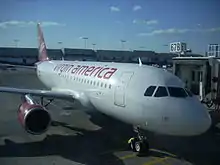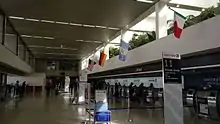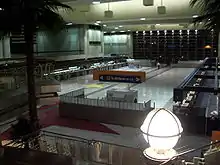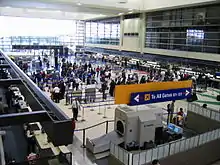Terminals of Los Angeles International Airport
The Terminals of Los Angeles International Airport have a total of 133 gates in nine passenger terminals arranged in the shape of the letter U or a horseshoe. At Los Angeles International Airport, passengers may move between terminals via a shuttle bus, or through various inter-terminal pedestrian connections.

In addition to these terminals, there are 2 million square feet (190,000 m2) of cargo facilities and a heliport operated by Bravo Aviation. Qantas[1] has a maintenance facility even though this is not a hub for them.
Inter-terminal connections
The Tom Bradley International Terminal and Terminals 2, 3, 4, 5, 6, 7, and 8 are all connected airside via a Delta Air Lines airside shuttle bus between terminals 2, 3, and Tom Bradley International Terminal,[2] overground passage between Terminal 4 and the Tom Bradley International Terminal, a tunnel between Terminals 4, 5 and 6 and above-ground walkways between Terminals 6, 7, and 8. An additional airside shuttle bus operates between Terminals 4, 5, and the American Eagle remote terminal. There are no physical airside connections between terminals 1 and any other terminals.
Inter-terminal connections between terminal 1 and all other terminals require passengers to exit security and then walk or use the free LAX shuttle-buses that run on World Way lower level. Passengers must then re-clear security to enter the other terminals. Terminals 2, 3, and Tom Bradley (TBIT) are served by a Delta Air Lines shuttle bus, and there are specific gates in the airside area where passengers are able to board a shuttle bus and transfer between them without exiting security.[2] Terminals 4–8, which comprise the south terminal complex, provide airside connections walkways, which allow connecting passengers to access other terminals without having to re-clear security.
LAX Train
LAX APM | |||||||||||||||||||||||||||||||||||||||||||||||||||||||||||||||
|---|---|---|---|---|---|---|---|---|---|---|---|---|---|---|---|---|---|---|---|---|---|---|---|---|---|---|---|---|---|---|---|---|---|---|---|---|---|---|---|---|---|---|---|---|---|---|---|---|---|---|---|---|---|---|---|---|---|---|---|---|---|---|---|
| |||||||||||||||||||||||||||||||||||||||||||||||||||||||||||||||
As part of the Landside Access Modernization Program (LAMP), Los Angeles World Airports (LAWA) is planning to construct LAX Train, an automated people mover which consists of approximately 2.25 miles (3.62 km) of elevated guideway and six stations. Headways are expected to be as low as 2 minutes between trains.[3] Construction of LAX Train started in 2017, and is anticipated to be completed by 2023.[4]
The three westernmost stations will be centrally located near the parking structures, and connect to their respective terminals via pedestrian bridges:
- West Station, serving Terminals 3, 4, and the Tom Bradley International Terminal
- Center Station, serving Terminals 2, 5, and 6
- East Station, serving Terminals 1, 7, and 8
LAX Train will provide access to transportation options:
- Intermodal Transportation Facility (ITF) West Station, allowing access to LAX Train for private vehicles, hotel and commercial shuttles, and bus transit.
- Metro/ITF East Station, connecting to the Los Angeles Metro Rail at the Aviation/96th Street station, scheduled to open in 2021.[5]
- Consolidated Rent-A-Car (ConRAC) Station, the eastern terminus at a new consolidated rental car facility.
Terminal 1
Terminal 1 has 13 gates: Gates 9, 10, 11A–11B, 12A–12B, 13–15, 16, 17A–17B, and 18A–18B, and is the home of the Southwest LAX base. Terminal 1, with main tenant PSA (Pacific Southwest Airlines), was built in 1984. Terminal 1 completed an extensive renovation financed by Southwest Airlines. This renovation was completed in late 2018 and provides updates to the security screening area, curbside dropoff, terminal areas and baggage handling.[6] Former tenants of the terminal include AirTran Airways, Pacific Southwest Airlines, America West Airlines, and US Airways.
Terminal 2

Terminal 2 has 12 gates: Gates 21–21B, 22–22A, 23–23A, 24–24A, and 25–28 and along with Terminal 3, it’s the hub for Delta at LAX. It also hosts several foreign carriers, including Aer Lingus, Aeroméxico, Virgin Atlantic, and WestJet. Virgin Australia and Volaris also use Terminal 2 for check-in of passengers.
Terminal 2 was built in 1962, and was the original international terminal. It was completely torn down and rebuilt in stages between 1984 and 1988 at a cost of $94 million.[7] The rebuilt terminal was designed by Leo A Daly.[8] Terminal 2 has CBP (Customs and Border Protection) facilities to process arriving international passengers but arriving Aer Lingus passengers normally use the same arrival facilities as domestic passengers since they have already cleared CBP inspections at their departure airports.
Former tenants of the terminal include Northwest Airlines and Pan American World Airways.
Their are two airline lounges in Terminal 2 with the Delta SkyClub and Virgin Atlantic Clubhouse both being located on the mezzanine level of the concourse.
Terminal 3
Terminal 3 has 12 gates: Gates 30, 31A–31B, 32, 33A–33B, 34–36, 37A–37B, and 38 (gate 39 was removed to make room for Virgin Australia Boeing 777 operations at gate 38) and houses Delta’s hub operation at the airport along with Terminal 2. Terminal 3 opened in 1961 and was Trans World Airlines' terminal. Eastern Air Lines initially also shared space as a tenant. The terminal was expanded in 1970 to accommodate widebody operations and between 1980 and 1987, which included a new passenger connector building and baggage system connected to the original satellite.[9] It formerly housed some American Airlines flights after that airline acquired Reno Air and TWA in 1999 and 2001, respectively. Virgin America was also based here from 2008-2017 until the Alaska Airlines merger moved them to terminal 6. US Airways was housed[10] in Terminal 3 after renovations were started in Terminal 1 from February 2014 until eventually, all American flights were moved to Terminal 4. As of May 2017, Copa Airlines, Avianca, and Interjet used Terminal 3 for check-in of passengers. As of November 2020, Terminal 3 is closed and demolition has begun to accommodate the Delta Air Lines SkyWay project. The reconstructed Terminal 3 is expected to re-open in mid-2022. The pace of construction was accelerated due to the decline in passenger air travel as the result of the global COVID-19 pandemic.[11]
Terminal 3 has one Delta SkyClub.
Terminal 4
Terminal 4 has 16 gates: Gates 40–41, 42A–42B, 43–45, 46A–46C, 47A–47B, 48A–48B, and 49A–49B, and it functions as the hub for American at LAX along with Eagles Nest, where American’s regional operations are located. Terminal 4 was built in 1961, was expanded in 1983 by adding a connector from the ticketing areas to the original satellite,[9] and was renovated in 2002 at a cost of $400 million in order to improve the appearance and functionality of the facility. The renovation was designed by Rivers & Christian.[12] Some international departures operate at TBIT.
American Airlines and American Eagle have more gates than any other airline at LAX, with 28 (American Airlines operates from 32 gates in total, including 9 gates at the American Eagle satellite terminal, 4 dedicated gates at Terminal 5, as well as 4 rotating gates at Tom Bradley International Terminal).
Terminal 4 has one American Airlines Admirals Club in the main concourse and one in the American Eagle satellite terminal.
Terminal 5
Terminal 5 has 15 gates: Gates 50A–50B, 51A–51B, (Gates 52A–52I are located at the American Eagle Terminal), 53A–53B, 54A–54B, 55A, 56–57, 58, and 59, and it serves as the operating base for JetBlue at LAX. The terminal is used by American Airlines (most of their flights operate from Terminal 4 or Eagles Nest), American Eagle (all American Eagle flights operate at Eagle's Nest), Allegiant Air, Frontier Airlines, Hawaiian Airlines, JetBlue, Spirit Airlines, and Sun Country Airlines. Western Airlines occupied this terminal at its opening in 1962, and continued to do so until Western was merged with Delta on April 1, 1987. Terminal 5 was redesigned by Gensler,[13] expanded to include a connector building between the original satellite and the ticketing facilities and remodeled from 1986 through early 1988. It was unofficially named 'Delta's Oasis at LAX' with the slogan 'Take Five at LAX' when construction was completed in the summer of 1988. Northwest Airlines moved all operations to Terminal 5 and Terminal 6 alongside Delta on June 30, 2009, as part of its merger with the airline.
Delta, which had been based for decades in Terminal 5 (with additional gates in Terminal 6), moved to Terminals 2 and 3 between May 12–17, 2017 in order to relieve overcrowding and provide better and easier transfers with its airline partners at Tom Bradley International Terminal.[14]
American Eagle flights operate from a satellite terminal that is located just east of Terminal 8. This terminal has 9 gates that supplement American's mainline operation at Terminals 4 and 5.
In July 2020, JetBlue announced that they would close their Long Beach operating base due to their routes underperforming there and because the officials at Long Beach refused to build a customs facility at LGB. As a result, JetBlue announced they would create a new operating base at LAX, as they planned a big expansion at the airport. JetBlue opened their LAX operating base on October 7, 2020 at Terminal 5. Because they moved their base to Los Angeles, they were able to expand domestically and internationally on the West Coast.
American Airlines has one Admirals Club in the terminal, occupying the space of the former Delta SkyClub.
Terminal 6

Terminal 6 has 14 gates: Gates 60–63, 64A–64B, 65A–65B, 66, 67, 68A–68B, and 69A–69B. Parts of this terminal have changed little from its opening in 1961; in 1970, new gates were expanded from the main building, as is obvious from the rotunda at the end. Four of these gates have two jetways, which can accommodate large aircraft. An expansion of the terminal, including a connector of the original satellite to the ticketing areas, was completed in 1987.[15]
Terminal 6 is the hub for Alaska Airlines. It is currently used by Alaska Airlines, Air Canada, Boutique Air, Mokulele Airlines, and VivaAerobus.
Continental Airlines originally built the Connector Building (which links the Ticketing and rotunda buildings). Prior to October 2014, United Airlines used the connector gates, supplementing its base at Terminal 7. Delta also leased some space from the Airport in Terminal 6, in addition to its base at Terminal 5. Most of the rotunda gates can feed arriving passengers into a sterile corridor that shunts them to Terminal 7's customs and immigration facility.
In April 2011, Alaska Airlines agreed to a deal with Los Angeles World Airports to renovate Terminal 6 and build an Alaska Airlines Board Room Lounge. The airline moved its flights to Terminal 6 on March 20, 2012, and Spirit Airlines was relocated to Terminal 3.[16]
Former tenants of the terminal include Continental Airlines until its merger with United Airlines in 2011, Eastern Air Lines which went bankrupt in 1991, and Great Lakes Airlines until its shut down in 2018. The terminal also originally housed Pacific Southwest Airlines and as well Virgin America until its merger with Alaska Airlines in 2018.
Terminal 7

Terminal 7 has 15 gates: Gates 70A–70B, 71A–71B, 72A–72B, 73, 74A–74B, 75A–75B, 76A–76B, and 77A–77B. Terminal 7, along with Terminal 8 is the hub for United at LAX. This terminal opened in 1962 and was expanded to accommodate widebody aircraft in 1970.[15] The terminal was expanded in 1982 with the addition of a connector building, which today consists of gates 70A-70B and 71A-71B.[15] Four of these gates have two jetways, which accommodate large aircraft. The interior of the terminal was renovated between January 1998 and June 1999 at a cost of $250 million, was designed by HNTB, and was constructed by Hensel Phelps Construction. Added were new gate podiums, increased size of gate areas, relocated concessions, expanded restrooms, new flooring, and new signage.[17] Also, the roof of the terminal was raised, and new, brighter light fixtures were added in order to provide more overall lighting.[18] In 2017, Terminal 7 has undergone another facelift, with significant changes to concessions. The terminal also contains a United Club and a United Polaris Lounge. The terminal has a customs area located on the arrivals floor, used by international flights served by United Airlines.
Terminal 8
Terminal 8 has 8 gates: Gates 80-85,86A-B. Along with Terminal 7, this functions as the hub for United. This terminal was originally constructed in 1961 as Concourse 8 and was redeveloped in 1982 and renamed Terminal 8.[15] The terminal formerly served Shuttle by United flights. At one point, only United Express flights arrived and departed from Terminal 8. Non-United Express flights arrived and departed from Terminals 6 and 7, Terminal 8 is now used once again for some mainline flights.
Tom Bradley International Terminal (Terminal B)



The Tom Bradley International Terminal (TBIT), sometimes referred as Terminal B,[19] has 28 gates: Gates 130–159.[20] Each gate is equipped with a Safegate Advanced – Visual Docking Guidance System. Nine satellite gates for international flights are located remotely on the west side of the LAX airfield, where passengers are ferried to the gates by bus. The terminal hosts most of the major international airlines, with the exception of those housed in Terminal 2. Some American, Delta and United flights operate from this terminal for international flights.
This terminal opened for the 1984 Summer Olympic Games and is named for Tom Bradley, the first African-American and longest-serving (20 years) mayor of Los Angeles, and champion of LAX. The terminal is located at the west end of the passenger terminal area between Terminals 3 (Delta Air Lines) and 4 (American Airlines). Tom Bradley International Terminal hosts 29 airlines and handles 10 million passengers per year.
In 2010, modernization efforts resulted in additional space for inline baggage screening, three large alliance-aligned lounges plus one unaffiliated lounge (to replace the multiple airline specific lounges) and cosmetic upgrades in the departures and arrivals areas.
On November 17, 2008, Mayor Antonio Villaraigosa unveiled design concepts for LAX's Bradley West and Midfield Concourse projects. Los Angeles World Airports (LAWA), along with city officials, selected Fentress Architects in association with HNTB to develop a design concept for the modernization of LAX. The emphasis of the modernization is to improve the passenger experience and to keep Los Angeles competitive with other global cities.
On February 22, 2010, construction began on the Bradley West project, part of the multi-year $4.11 billion LAX improvement and redevelopment projects. The project added over 1.25 million square feet (116,000 m2) of shops, restaurants, and passenger lounges, as well as new security screening, customs, immigration, and baggage claim facilities. The terminal's existing two concourses were demolished and replaced with a larger pair with 18 gates. The terminal opened in phases beginning on September 2012, and was completed in 2014.[21] The final cost of the terminal was approximately $2 billion, which ended up being much higher than the original estimate of $1.4 billion in late 2009.[22]
On September 18, 2013, the new Tom Bradley International Terminal at LAX officially opened. Airlines started to use the new, smarter gates that can handle larger aircraft, with nine 3-jetway gates configured to accommodate the Airbus A380. Inside, Southern California scenes and eccentric videos are played on seven huge multimedia screens. It is the largest immersive system in an airport and the most advanced multimedia environment in a North American airport. This system was created by Moment Factory.[23] Lounge-like seating for relaxation, and the 25,000-square-foot duty-free shopping area are located in the Great Hall. Many restaurants and high-end shops are located there, such as Chloé, Burberry, Fred Segal, and Porsche amongst others. Franchises of popular LA restaurants including Umami Burger, 800 Degrees, Larder, Ink.Sack and Lucky Fish are among the restaurant selections available.[24] The Midfield Satellite Concourse is scheduled to open by 2021.[25]
The terminal hosts multiple airline and third party lounges. They are the: Etihad lounge, Emirates Lounge, Los Angeles International Lounge, Korean Air Lounge, Oneworld Business Lounge, Star Alliance Lounge, Qantas International First Class Lounge, and the American Express Centurion Lounge.
Accommodating the Airbus A380
On March 25, 2007, Runway 7R/25L reopened after being shifted 55 feet (17 m) south to prevent runway incursions and prepare the runway for the Airbus A380. Additional storm drains and enhanced runway lighting were added. Runway 25L is now 800 feet (240 m) south of the parallel runway centerline to centerline, allowing a parallel taxiway between the runways; the taxiway was completed in 2008.
On September 18, 2006, Los Angeles World Airports started a $503 million facelift of the Tom Bradley International Terminal. Improvements included new paging, air conditioning and electrical systems, along with new elevators, escalators, baggage carousels, and a digital sign that automatically update flight information. With federal funding, explosives-detection technology was incorporated into the terminal's underground baggage system.
Between 2000 and 2007, LAX has lost 12% of the seats on its weekly international departures as many Pacific Rim carriers began reducing flights to LAX in favor of more modern airports, such as San Francisco International Airport and Seattle–Tacoma International Airport, due to the aging Tom Bradley International Terminal.[26]
On August 15, 2007, the Los Angeles City Council approved a $1.2 billion project to construct a new 10-gate terminal to handle international flights using the Airbus A380.[27] Adding the first new gates built since the early 1980s, the new structure was to be built directly west of the Tom Bradley International Terminal on a site that was occupied mostly by aircraft hangars.[27]
On March 19, 2007, the Airbus A380 made its debut at LAX, landing on runway 24L. Though LAX was originally to be the first U.S. city to see the A380, Airbus later decided to forgo LAX in favor of John F. Kennedy International Airport in New York City. After city officials fought for the super-jumbo jet to land at LAX, Airbus had to get two A380s, which landed simultaneously in New York and Los Angeles.[28]
On March 31, 2008, the Los Angeles Times reported that foreign carriers were once again flocking to LAX's Tom Bradley International Terminal. The weaker dollar caused a surge in demand for U.S. travel, resulting in airlines either adding new destinations or increasing frequencies to existing routes. New airlines that introduced flights to LAX included Virgin Australia, Emirates, Turkish Airlines, Iberia, Korean Air, Qantas, Air China, and Air France. The influx of new flights comes amidst the renovation of the airport and consolidates LAX's status as the premier international gateway to the Western United States.[29]
Qantas launched service with the Airbus A380 on October 20, 2008, using the west side remote gates. Though initially deployed between LAX and Sydney, Qantas's A380 service was extended to the LAX-Melbourne route. This was followed shortly by Korean Air, which initiated nonstop A380 flights to Seoul-Incheon in October 2011. Air France has launched A380 flights between Paris–Charles de Gaulle and Los Angeles in May 2012. In addition, China Southern Airlines launched A380 service to Guangzhou in October 2012, representing an increase in capacity of 78% on the route. With the addition of these services, LAX boasted six daily A380 services. On October 15, 2013, British Airways' nonstop service from London–Heathrow to LAX also became an A380 route.[30]
Asiana Airlines launched an Airbus A380 service to LAX on Wednesday, August 20, 2014. This new A380 route makes Asiana the eighth A380 operator at LAX and the eleventh airline to operate an A380. Previously, Asiana deployed regional Asian A380 routes to Osaka, Hong Kong, and Bangkok from Seoul.[31]
LAX has more A380 services than any other North American city, with up to thirteen daily flights spread among seven operators (as of October 2020): Emirates, China Southern Airlines, British Airways, Qantas, Korean Air, Asiana Airlines, and Lufthansa.
American Eagle Regional Terminal (Eagle’s Nest)
The Regional Terminal has nine gates: Gates 52A–52I, and is used exclusively for American Eagle flights, which is why it is also known as “the Eagle’s nest.”[32] It serves as the remainder of American’s hub operations in Los Angeles, supplementing Terminal 4.
The terminal is located on the south side of the airport, east of Terminal 8 (United Terminal) and across Sepulveda Boulevard. As it is physically separated from the other terminal buildings, passengers access the Regional Terminal using a system of shuttle buses. Buses operate between the Regional Terminal and Terminal 4 and Terminal 5, which house American Airlines' other gates.[33]
The Regional Terminal’s gate numbers (52A–52I) are meant to encourage passengers originating their travel from LAX to enter the airport through the less congested Terminal 5 and board the bus at a stop located at Gate 52. But as the majority of American Airlines' mainline fights at LAX operate out of Terminal 4, a separate bus service is additionally operated to that terminal to minimize connection times.[34]
The terminal has a covered walkway and ramp at each gate for access and egress to the aircraft instead of jet bridges. The terminal features an Admirals Club lounge, restrooms, seating areas with power outlets, and a concession area.
The terminal originally handled United Express flights (gates 71C-71K) until it was vacated in 2005.[35] American Eagle flights were relocated to the terminal in January 2010 from a remote terminal which was 0.3 mi (500 m) west of Terminal 4 that would later be demolished.
References
- "Mayor Villaraigosa Announces New Qantas Maintenance Facility at LAX". Business Wire. February 1, 2006. Retrieved April 3, 2008.
- "Los Angeles International Airport Terminal Map & Sky Club (LAX) : Delta". www.delta.com. Retrieved 2020-06-11.
- "The Solution". Connecting LAX. City of Los Angeles. Retrieved 16 August 2017.
- "Anticipated Process and Schedule". Connecting LAX. City of Los Angeles. Retrieved 16 August 2017.
- "Airport Metro Connector 96th Street Transit Station". Los Angeles County Metropolitan Transportation Authority. Retrieved 16 August 2017.
- "Los Angeles International Airport Terminal 1 Renovation" (PDF). T1. Retrieved April 25, 2016.
- Malnic, Eric (June 1, 1988). "'Final Major Link' in LAX Expansion Opens". Los Angeles Times.
- "LAX Terminal 2 to Be Revamped : Carriers Expect $94-Million Project to Start Next Month". Los Angeles Times. August 17, 1986.
- "LAX Specific Plan Amendment Study Draft EIR" (PDF). Los Angeles World Airports. July 2012. pp. 4–349. Retrieved January 22, 2015.
- "US Airways Ends Operations In LAX's Terminal 1, Relocates To Terminal 3". CBS 2. February 12, 2014. Retrieved July 22, 2019.
- "Delta, Los Angeles International Airport accelerate terminal transformation by 18 months". Delta Air Lines. November 12, 2020. Retrieved December 1, 2020.
- Oldham, Jennifer (August 1, 2002). "Remodeled Terminal at LAX Debuts". Los Angeles Times. Retrieved June 14, 2012.
- Whiteson, Leon (August 21, 1988). "Architectural Firm Practices One-Stop Design : Gensler & Associates Specializes in Planning Project's Inside as Well as Outside". Los Angeles Times.
- "LAX begins massive relocation of 15 airlines in the central terminal area". Los Angeles Times. May 12, 2017. Retrieved May 14, 2017.
- "United Airlines Los Angeles International Airport (LAX) Terminal 7 Improvement Project Initial Study – Proposed Negative Declaration" (PDF). Los Angeles World Airports. March 28, 2013. Retrieved January 22, 2015.
- "The All-New Alaska Airlines Terminal 6 at LAX". Alaska Airlines. Retrieved March 20, 2012.
- "United Begins $200 Million Terminal Expansion at LAX". Flight Global. Archived from the original on May 22, 2014. Retrieved August 13, 2013.
- "Archived copy". Archived from the original on May 12, 2001. Retrieved May 12, 2001.CS1 maint: archived copy as title (link)
- "Airline Terminal Location Map". Los Angeles World Airports. Retrieved October 25, 2018.
- https://www.flylax.com/-/media/flylax/terminal-map-files/tbit.ashx
- "LAX Development Program". Los Angeles World Airports. Retrieved January 12, 2012.
- "City audit uncovers big cost increases for new LAX Bradley terminal". Los Angeles Times. Retrieved June 28, 2018.
- from Moment Factory Plus (June 20, 2013). "Moment Factory making-of: LAX new terminal, the largest immersive system in an airport on Vimeo". Vimeo.com. Retrieved October 29, 2013.
- Hallock, Betty. "Travelers could be eating very well, very soon at modernized Tom Bradley terminal at LAX". LA Times. The Los Angeles Times. Retrieved July 9, 2014.
- https://spectrumnews1.com/ca/la-west/travel/2020/10/27/if-you-haven-t-been-to-lax-recently--here-s-what-s-been-going-on
- Oldham, Jennifer (February 23, 2007). "LAX watches world go by; Cramped facilities push Pacific Rim carriers to newer airports". Los Angeles Times. p. A1. Retrieved June 10, 2020.
- Steve Hymon, Council OKs 10 new gates at LAX, Los Angeles Times, August 16, 2007
- Salvo, Christina (March 19, 2007). "abc7.com: World's Largest Airliner Lands at LAX 3/19/07". Abclocal.go.com. Archived from the original on March 22, 2007. Retrieved December 6, 2010.
- Pae, Peter (March 31, 2008). "Foreign airlines flock to LAX". Los Angeles Times. Retrieved September 26, 2010.
- "British Airways' Red Carpet Scheduled Debut for the A380". March 5, 2013. Retrieved March 24, 2013.
- "WHERE IS THE A380 FLYING?". March 2014. Retrieved August 27, 2014.
- Nguyen, John (May 18, 2016). "American Quietly Updates, Enhances Operations at LAX – AirlineReporter". Airline Reporter. Retrieved May 8, 2018.
- "Changes To The American Eagle Terminal LAX". One Mile at a Time. May 19, 2016. Retrieved May 8, 2018.
- "American Airlines at LAX to Relocated Four Aircraft Gates". Aviation Pros. January 30, 2017. Retrieved May 8, 2018.
- https://www.aviationpros.com/home/news/10433686/united-closes-commuterflight-remote-terminal-at-lax
